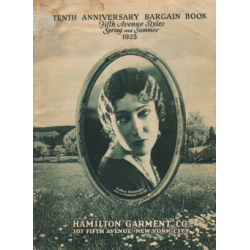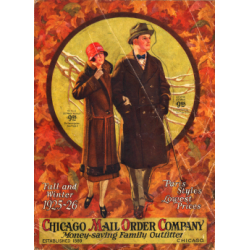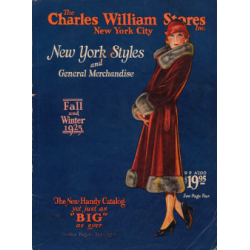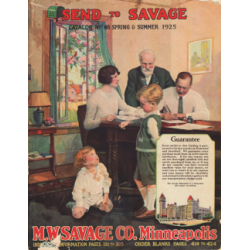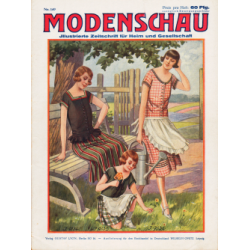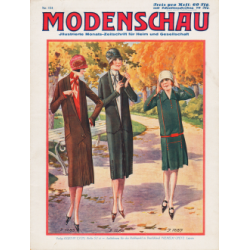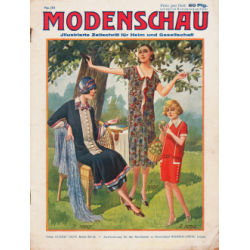Fashion 1925
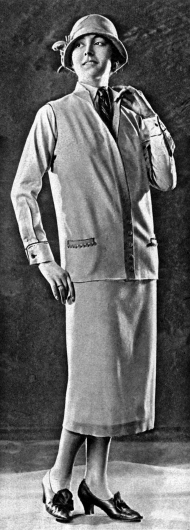 Fig. 1. Snappy and masculine suit consisting of skirt, vest and jacket. Photo: Joel Feder, New York City (biographical data unknown)
—
Modenschau Issue #149, May 1925, p. 12-10a
Fig. 1. Snappy and masculine suit consisting of skirt, vest and jacket. Photo: Joel Feder, New York City (biographical data unknown)
—
Modenschau Issue #149, May 1925, p. 12-10a
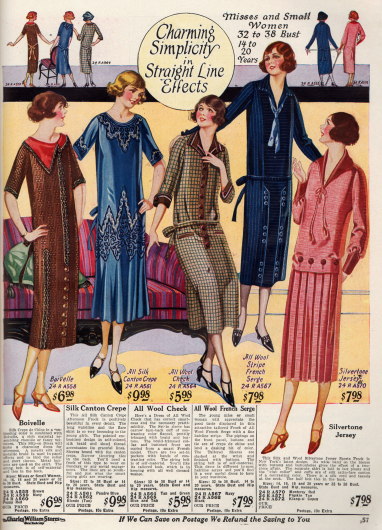 Dresses in "charming simplicity and straight line effects"
—
Charles William Stores Inc. Fall/Winter 1925, p. 57
Dresses in "charming simplicity and straight line effects"
—
Charles William Stores Inc. Fall/Winter 1925, p. 57
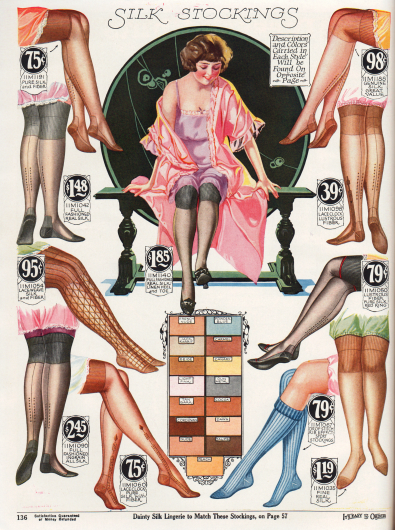 Shorter skirts and new colors: silk hosiery with decorative stitching in more lighter shades
—
M. W. Savage Co. Spring/Summer 1925, p. 136
Shorter skirts and new colors: silk hosiery with decorative stitching in more lighter shades
—
M. W. Savage Co. Spring/Summer 1925, p. 136
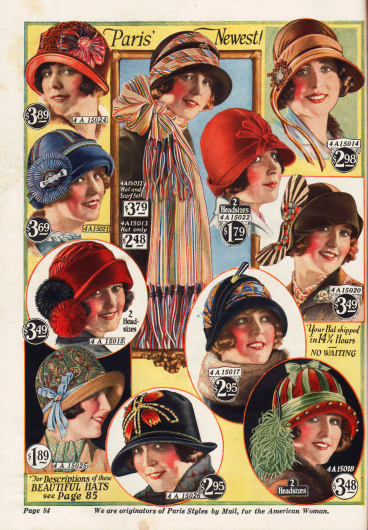 Hats with short, rolled brims, decorated with ostrich feathers and other decorative ornaments
—
Chicago Mail Order Co. Fall/Winter 1925, p. 84
Hats with short, rolled brims, decorated with ostrich feathers and other decorative ornaments
—
Chicago Mail Order Co. Fall/Winter 1925, p. 84
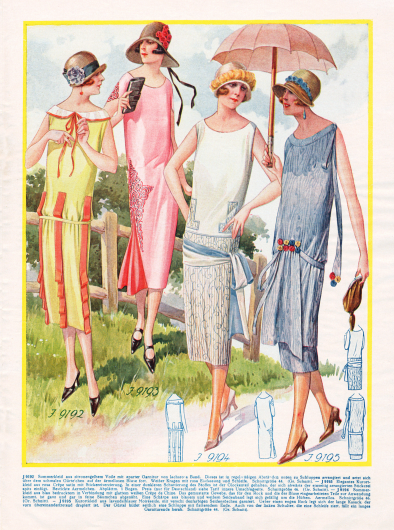 Sleeveless spa and summer dresses made of voile, crepe satin, crepe de chine and moire silk
—
Modenschau Issue #149, May 1925, p. 12-10e
Sleeveless spa and summer dresses made of voile, crepe satin, crepe de chine and moire silk
—
Modenschau Issue #149, May 1925, p. 12-10e
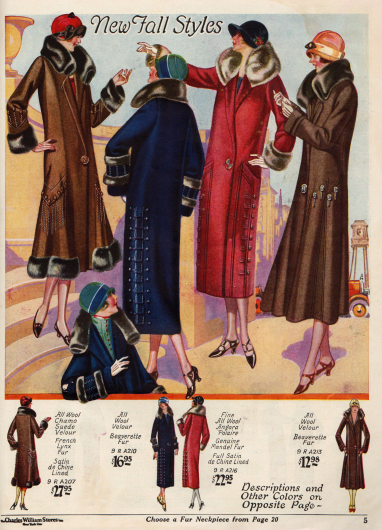 Fur trimmed winter coats. Two coats with the new bell-shaped hems, a new fall fashion feature
—
Charles William Stores Inc. Fall/Winter 1925, p. 5
Fur trimmed winter coats. Two coats with the new bell-shaped hems, a new fall fashion feature
—
Charles William Stores Inc. Fall/Winter 1925, p. 5
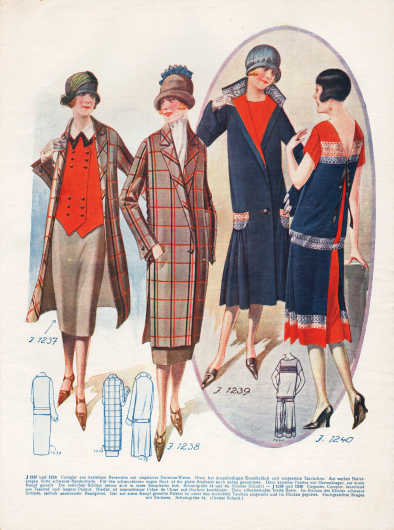 Ensemble with brick red vest and tea ensemble with paletot of blue and red crepe de chine — Modenschau, no. 153 (12), September 1925
Ensemble with brick red vest and tea ensemble with paletot of blue and red crepe de chine — Modenschau, no. 153 (12), September 1925
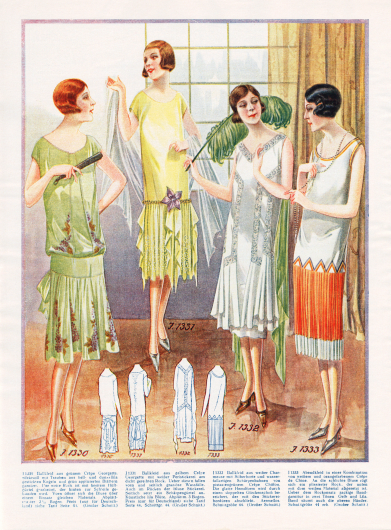 Knee length sleeveless evening dresses with draped or pleated skirts
—
Modenschau Issue #154, October 1925, p. 22b
Knee length sleeveless evening dresses with draped or pleated skirts
—
Modenschau Issue #154, October 1925, p. 22b
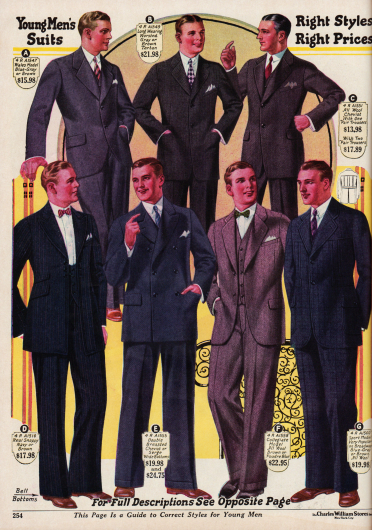 Men's suits and a "jazz suit" of wool fabrics in the new modern wide cut
—
Charles William Stores Inc. Fall/Winter 1925, p. 254
Men's suits and a "jazz suit" of wool fabrics in the new modern wide cut
—
Charles William Stores Inc. Fall/Winter 1925, p. 254
Women's fashion in 1925 was decidedly masculine, and quite some ladies were only too eager to make use of the gentleman's wardrobe. Ties, bowler hats, suit shirts, men's paletots and trench coats were popular items of clothing that were used to provoke and attract attention. Some of the particularly bold ladies even wore trouser suits or tuxedos for the evening. The straight, shapeless silhouette and hair cut into a short bob, shingle or Eton crop left no doubt about the preference for androgynous lines. The fashion à la Garçonne in Europe, or simply known as the flapper fashion in the US, reached the height of its popularity in 1925.
The preference for the men's fashion line was also particularly evident in the tailor-made suit (fig. 1), which was then sometimes referred to as a "trotteur" or walking suit when worn in the city in the morning. Cuffs, double-breasted or single-breasted button plackets with leather buttons as well as the cut and line of the suit jacket were strongly reminiscent of its male counterpart, the jacket.
The deliberate provocation did not fail to have an effect. A commentary of indignation appeared in the Berliner Illustrierte Zeitung on March 29 under the title "Enough is Enough!":
"What started as a playful game in women’s fashion is gradually becoming a distressing aberration. At first it was like a charming novelty: that gentle, delicate women cut their long tresses and bobbed their hair; […] that they shortened their skirts, exposing their slender legs up to calf level. […] [F]ashion was increasingly calculated to make women’s outward appearance more masculine. […] And we observe more often now that the bobbed haircut with its curls is disappearing, to be replaced by the modern, masculine hairstyle: sleek and brushed straight back. […] It is high time that sound male judgment take a stand against these odious fashions.“1
The supposed masculinization of women's fashion also caused a controversial debate in the USA. However, masculine fashion and the blurring of traditional roles of both sexes also became the subject of satirical songs. The title Masculine Women, Feminine Men was interpreted by many jazz bands and orchestras of the decade and became very popular in the following years.
Exhibition Gives Art Déco its Name
It was only the Exposition internationale des Arts Décoratifs et industriels modernes, which took place in Paris between April and October 1925, that gave the arts and crafts and industrial design its own name after the First World War. Although the Art Deco style is expressed primarily in architecture, interior decoration and art, fashion is not completely unaffected by the new art movement. Thus in the following years cubist and abstract fabric designs became more and more popular and accepted by the fashion industry and couturiers.
Wide but Short Skirt in Spring
This year, Parisian haute couture presents shorter skirts than ever before. Starting with the calf-length skirt at the beginning of the year, the hem of the skirt climbs up to just above the calf until spring - and ends between calf and knee at the end of the year. The airy spring fashion is accompanied by short, sometimes only hinted sleeves. Fabrics such as light silks, kashas, silk rips, alpaca and crêpe satin set the tone.
In contrast to last year's slender, tube-like dress line, this spring a lot more bell-shaped skirt styles are taking hold. Deep or hidden pleats, incorporated godets, pleated parts, light pleated fabrics and pleated inserts extend the skirt and give the wearer more freedom of movement. However, in many dresses the skirt widens at thigh or even knee level, so that the straight line is only interrupted by the wide hem. Flounces are also effectively used to extend the skirt.
While the skirt hem of the dresses increases in width, the shape of the coats remains narrow. Only in the course of the year does the cloakroom hem take over the width of the dresses. Bell-shaped side panels and inserts give the autumn coats a completely new line, which is further emphasized by the use of narrow fur trimming around the hem. Even fur coats for the winter and fur-trimmed evening coats are part of the new width.
Waistline Moves Higher Again
Coat dresses with button plackets and one-piece dresses that continue to propagate the very straight line are still fashionable. Many simple day dresses only hint at the waist and also do without a belt. Often, the top of the dress is only visibly separated from the skirt at the base of the skirt. Sometimes the waistline is only hinted at by pockets, buttons or embroidery and lies at the height of the hips.
On the other hand, there are also initial tendencies to raise the waistline again, e.g. through new lines.2 Some fashion houses such as Paquin, Vionnet, Martial & Armand and Patou are showing some spring models with slightly higher waistlines.3 Some of these dresses feature the new princess shape, which is characterized by a shortened (narrower) waist in combination with the wider skirt. This new, slightly curved line gives the dress a feminine outline yet again. As an alternative to the otherwise so masculine and sporty dress line, this fashion has achieved a certain success that will increase in the coming years.
Ensembles Great Fashion
This spring, the two or three-piece ensemble, consisting of either a blouse, skirt and a matching coat or a well-matched dress and coat, takes on a special significance and pushes the meaning of the tailor-made suit into the background. Several dresses for different times of day and occasions can be combined to a well chosen coat. Such a coat can be worn with a simple running dress in the morning, while in the afternoon an elegant formal dress for a five o'clock tea or even a dance dress can be considered. A somewhat more casual variation is the sport ensemble, which is conveniently worn with a dress and sweater.
It is important for the ensemble that the coat and dress match in some detail. This can be achieved, for example, by using one color of the coat on all dresses and optional accessories. However, "too much matching is inelegant. Just one bold detail can give the suit a chic touch,"4 advises fashion jurnalist Johanna Thal her readers in the second spring fashion issue of Die Dame. Effective fabric combinations for coat and dress are wool and silk, wool kasha and crepe silk, rep and faille silk, ottoman and light crepe, whereby the coat lining is always made of the dress fabric. The ensemble with its almost inexhaustible combination possibilities takes into account an era characterized by fast pace and the desire for uncomplicated comfort.
Tea Dance and Charleston Fever
Among last year's dances, the wild Charleston from the USA is still the undisputed leader. For the Tea Dance one likes to wear a light formal dress or dance dress, which is of course made of light and airy fabrics like georgette, silk or chiffon and can be in the fashionable color purple.
The evening fashion presents itself splendidly and in bright colors. The dance dresses, ball gowns and large evening dresses show spray of fabric flowers at the shoulder and all kinds of shimmering embroidery. Small bags made of gold and silver leather, feather fans with sparkling stones, tiaras as well as jewellery and shoes made of brocade or lamé with rhinestone trimmings, which can even be found on the heel, compete with each other in the sparkle.
Men's Fashion Shows New Lines
Traditionally, men's fashion is subject to much slower changes than women's fashion. Since the First World War, the general fashion for men has hardly changed. Only this year, a new line in men's fashion is emerging, which replaces the tight and very tight cut of jacket and suit trousers.
Similar to women's fashion, in 1925 the very high, tight waist of jackets in men's fashion disappeared in favour of a lower and more discreet waist at the height of the natural waist. Wide shoulders are emphasized and the transition to the sleeve is soft and rounded. Overall the cut is more generous. The lapel becomes wider and is now noticeably deeper, making it longer. However, it is entirely up to the gentleman's taste whether the jacket should rather be with lapels worked up or down. Likewise, the question of the single or double-breasted jacket is up to the preference of the wearer.
Matching the jacket, the suit trousers, which are worn with creases and short lapels, also take on a completely new shape. The trouser legs, previously only ankle-length, are now cut longer so that the ankles are completely covered. But especially the width of the trouser legs is new, which can reach a circumference of up to 20 inches (about 50 cm) around the knee. These wide trousers were made popular by students from Oxford, as the wearing of knickerbockers has been banned at British universities and students have started to wear wide trousers over their knickerbockers. Hence the origin of the name Oxford Bags by which these trousers are also known in America.
The Elegant Gentleman is Wearing Stresemann
For special formal occasions in the morning and afternoon, the cutaway, or short cut, is obligatory for the well-dressed gentleman. The political protocol of the time also provides for the Cut for Reichstag sessions or acts of state, but it is too festive and inappropriate for normal government or office work. In order to facilitate the constant change of clothes between the Reichstag and the office, the German Foreign Minister Gustav Stresemann simply wears a black, single-breasted jacket instead of the cut to go with the black-grey striped trousers and black vest. To this suit, which is henceforth known as Stresemann, a white shirt with a stand-up collar or turn-down collar, a black tie or plastron (wide silk tie) and black shoes are generally worn.
Mode aus Katalogen und Zeitschriften des Jahres 1925
Footnotes
1 N. N., Nun aber genug! Gegen die Vermaennlichung der Frau, in: Berliner Illustrirte Zeitung, March 29, 1925, p. 389, quoted from: Deutsches Historisches Institut, Enough is Enough! Against the Masculinization of Women, in: https://ghdi.ghi-dc.org/sub_document.cfm?document_id=3881&language=english [last accessed: January 29, 2024].
2 N. N., Neue Kleiderformen, die auf die hoehere Taille vorbereiten, in: Die Dame, no. 14 (52), First April Issue 1925, p. 16.
3 N. N., Die neue Moderichtung: Hoehere Taille, weiter Rock. Ein Rundgang durch die Pariser Modehaeuser, in: Die Dame, no. 13 (52), Second March Issue 1925, pp. 12-15 and 62-66, here p. 12.
4 Original German quote: "Ein Zuviel an Uebereinstimmung ist unelegant. Gerade irgendein kuehn abstechendes Detail kann dem Anzug eine schicke Note geben", Thal, Johanna, Drei Kleider zu einem Mantel. Eine fuer die Fruehjahrsmode charakteristische Zusammenstellung, in: Die Dame, no. 14 (52), First April Issue 1925, p. 14.



